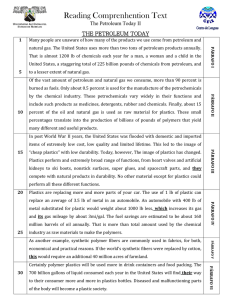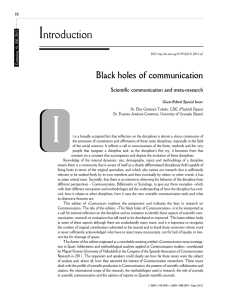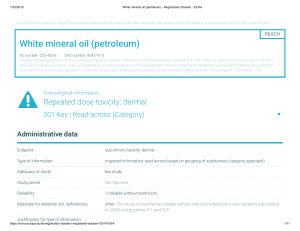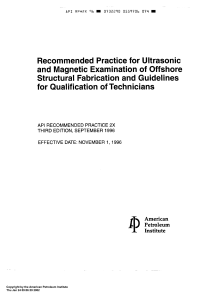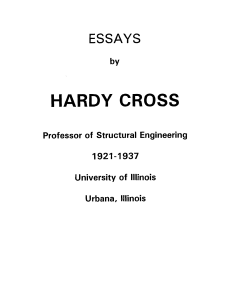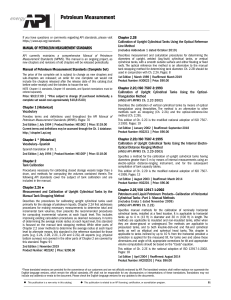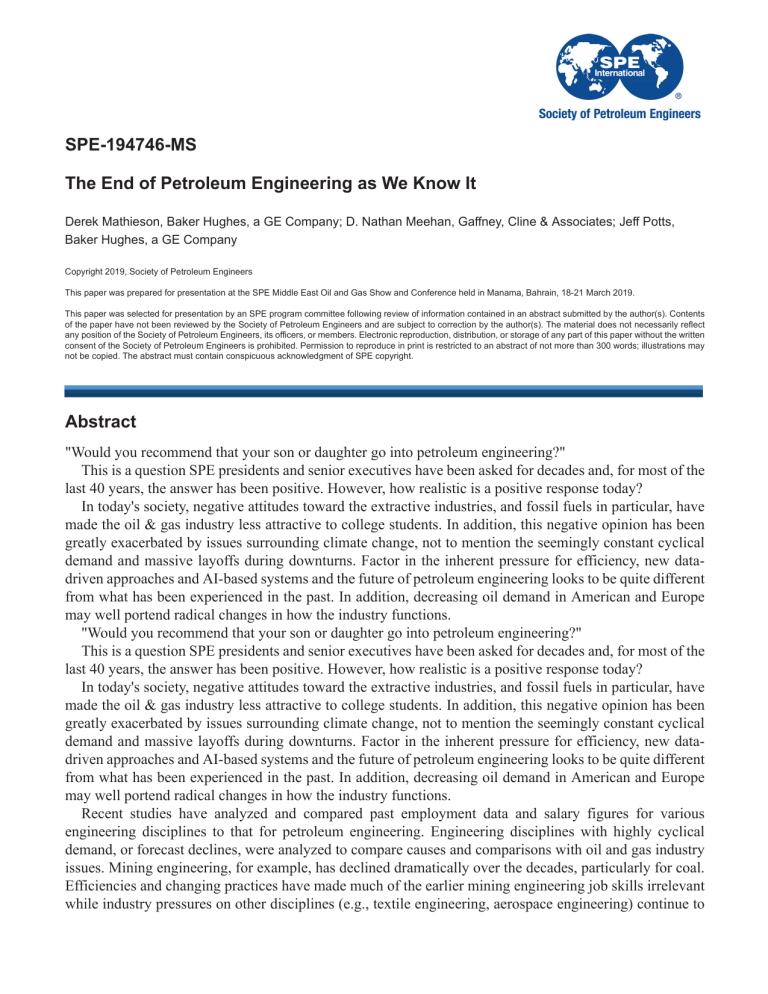
SPE-194746-MS The End of Petroleum Engineering as We Know It Derek Mathieson, Baker Hughes, a GE Company; D. Nathan Meehan, Gaffney, Cline & Associates; Jeff Potts, Baker Hughes, a GE Company Copyright 2019, Society of Petroleum Engineers This paper was prepared for presentation at the SPE Middle East Oil and Gas Show and Conference held in Manama, Bahrain, 18-21 March 2019. This paper was selected for presentation by an SPE program committee following review of information contained in an abstract submitted by the author(s). Contents of the paper have not been reviewed by the Society of Petroleum Engineers and are subject to correction by the author(s). The material does not necessarily reflect any position of the Society of Petroleum Engineers, its officers, or members. Electronic reproduction, distribution, or storage of any part of this paper without the written consent of the Society of Petroleum Engineers is prohibited. Permission to reproduce in print is restricted to an abstract of not more than 300 words; illustrations may not be copied. The abstract must contain conspicuous acknowledgment of SPE copyright. Abstract "Would you recommend that your son or daughter go into petroleum engineering?" This is a question SPE presidents and senior executives have been asked for decades and, for most of the last 40 years, the answer has been positive. However, how realistic is a positive response today? In today's society, negative attitudes toward the extractive industries, and fossil fuels in particular, have made the oil & gas industry less attractive to college students. In addition, this negative opinion has been greatly exacerbated by issues surrounding climate change, not to mention the seemingly constant cyclical demand and massive layoffs during downturns. Factor in the inherent pressure for efficiency, new datadriven approaches and AI-based systems and the future of petroleum engineering looks to be quite different from what has been experienced in the past. In addition, decreasing oil demand in American and Europe may well portend radical changes in how the industry functions. "Would you recommend that your son or daughter go into petroleum engineering?" This is a question SPE presidents and senior executives have been asked for decades and, for most of the last 40 years, the answer has been positive. However, how realistic is a positive response today? In today's society, negative attitudes toward the extractive industries, and fossil fuels in particular, have made the oil & gas industry less attractive to college students. In addition, this negative opinion has been greatly exacerbated by issues surrounding climate change, not to mention the seemingly constant cyclical demand and massive layoffs during downturns. Factor in the inherent pressure for efficiency, new datadriven approaches and AI-based systems and the future of petroleum engineering looks to be quite different from what has been experienced in the past. In addition, decreasing oil demand in American and Europe may well portend radical changes in how the industry functions. Recent studies have analyzed and compared past employment data and salary figures for various engineering disciplines to that for petroleum engineering. Engineering disciplines with highly cyclical demand, or forecast declines, were analyzed to compare causes and comparisons with oil and gas industry issues. Mining engineering, for example, has declined dramatically over the decades, particularly for coal. Efficiencies and changing practices have made much of the earlier mining engineering job skills irrelevant while industry pressures on other disciplines (e.g., textile engineering, aerospace engineering) continue to 2 SPE-194746-MS decrease demand. New job skills are evolving in these disciplines, perhaps changing the landscape of the traditional engineering training. It is likely that AI-based products and services will greatly leverage petroleum engineers, enabling one engineer to do the work previously requiring many. Approaches based on big data will also generate substantial leverage. Engineering designs to decrease carbon intensity and make hydrocarbon production more environmentally acceptable, and other factors, suggest that petroleum engineering jobs in the future are likely to be smaller in number and radically different from those of today. Realistically, the world will not run out of oil or gas. Fossil fuels will be a key part of the mix for decades to come. However, will the attraction exist that leads the best and the brightest to continue to join the industry? State of engineering today We have reviewed past employment data and salary figures for several engineering disciplines, analyzing and comparing them to that for petroleum engineering. The engineering disciplines with highly cyclic demand or in declining industries provide cautionary warnings. Figure 1 compares historical US starting salaries for petroleum, chemical, mechanical and electrical engineering. Salary data is presented both in nominal and inflation-adjusted values based on 2015 dollars. (Salary data outside the US is not readily available and there is a great deal of variation.) Mean values also originate from multiple sources and reflect survey responses from individuals who actually get jobs. During downturns, this is deceptive. However, the trends are clear: petroleum engineering salaries grow rapidly during price booms and have outpaced other engineering salaries since the 1979 OPEC oil embargo. Figure 1—Historical salaries for four engineering majors (Sources:NACE salary surveys, Judah, Jochen & Frailey) In contrast, demand for mining engineering graduates in the US has declined dramatically over the decades, particularly for coal. Efficiencies and changing practices have made earlier mining engineering skills increasingly irrelevant. The absolute number of mining engineering jobs has declined in the US and, to a lesser degree, worldwide, even as total global mining output has escalated. Many schools have dropped or scaled back their departments. Undergraduate enrollment in the 14 universities that conferred mining engineering degrees in 2014 was less than 500. Enrollments rose steadily to a peak in 2013 and have subsequently declined. SPE-194746-MS 3 With only about 200 mining engineering graduates annually, the US decline in the mining engineering profession seems permanent. Globally, mining is responsible for huge activity levels for everything from bauxite to diamonds. Other than coal and nickel, most mining activity is steady to increasing, but commodity prices for tin, aluminum, copper and iron affect activity levels in these industries in the same way oil and gas prices impact drilling. Chromium, rare earth oxides and mica mining have increased significantly (5) but these represent tiny volumes by global mining standards. Industry pressures on other disciplines (e.g., textile engineering, aerospace engineering) continue to decrease demand. At Georgia Tech in the early 1970s, there was a thriving department called "textile engineering," dealing with all aspects of the textile industry. That department is gone now, along with most of its peers at other schools; only one significant U.S. program remains. Although the world produces vastly more textile products today than in 1972, this discipline's decline has not changed. The Bureau of Labor Statistics has forecast a growth in demand for textile engineers of only 1% annually from 2016 to 2026, the lowest of any engineering discipline. Reported average salaries for textile engineers is in the range of entry-level salaries for other disciplines, making it difficult to attract talent to this discipline. Textile engineering's demise mirrors that of the US textile industry, which has seen most manufacturing leave the US for China, Vietnam and other lower cost countries. Like petroleum engineering, textile engineering is closely associated with one industry. This association is in spite of the high technology applications in textiles driven by specialty products for athletic performance, high temperature applications and nanotechnology advances. Of the major engineering programs, electrical engineering has had the most ups and downs. Mechanical engineering remains (by far) the most popular discipline, but EE usually ranks approximately the same as civil engineering and ahead of chemical and biomedical engineering. EE graduates have increased recently, but the number of people working as electrical engineers has dropped precipitously. The number of working US electrical engineers dropped from 385,000 in 2002 to 300,000 in 2014. Likewise, hiring of electrical engineers has grown quite slowly since 2008 (Figure 2), with the most significant growth rates in petroleum engineering, environmental engineering and computer science. Table 1 compares the annual growth rate in Bachelor's degrees granted by engineering discipline. Figure 2—Undergraduate degrees awarded (USA) in several disciplines 4 SPE-194746-MS Figure 3—Undergrauate degrees awarded (USA) by discipline Table 1—Growth rate in US undergraduate degrees Bachelor's Degrees 2008-2009 Growth Rate Petroleum 15% Environmental 12% Computer Science 11% Chemical 9% Civil/Environmental 9% Biological/Agricultural 9% Biomedical 8% Mining 8% Industr./Manuf./Systems 7% Metallurgical/Materials 7% Mechanical 6% Computer 6% Engineering Management 6% Electical/Computer 4% Engr. Science 4% Other Engineering 4% Aerospace 4% Engineering (General) 4% Nuclear 4% Electrical 2% Civil 2% Architectural -1% SPE-194746-MS 5 In contrast, much of the work that architects do can be replaced by increasingly sophisticated tools. Although creativity may be hard to replace, the skills and tools required to do the basic tasks can be replaced, or at least minimize the need, which may result in far fewer available jobs. Architecture degrees decreased more than 10% between 2010 and 2015 and architectural engineering was the largest discipline to see a decline in undergraduate degrees granted between 2008 and 2017. A common theme to some of the engineering disciplines that have been cyclical and face long-term decline (e.g., nuclear, textile, mining) is that the engineering discipline itself is closely linked to one specific industry. Dislocation or decline in that industry will lead to large layoffs and many of the "best and brightest" minds entering other fields. Modern AI-based diagnostic tools are proving themselves equally (or more) capable of diagnosing Xray images or other medical tests. Self-driving vehicles may threaten taxi and Uber drivers' jobs. But what of petroleum engineers? Can we be replaced? Engineering's future – Augmentation and Extension AI-based products and services can, and will, greatly leverage the skills of petroleum engineers in their work. Many people want to equate leverage with automation. If one engineer can do the work of twenty via simple automation, that means unless the other nineteen do something else, they are redundant. Many people connect AI with automation of roles and skills when in reality in the oil and gas sector, it will be highly focused on augmentation. Given the highly dynamic environment of technical operations in our sector, only 20-25% of the activities can be automated; however, 70-75% of those same operations can be augmented. Emerging technologies such as extended reality, along with techniques such as deep learning, will dramatically augment the workforce. Collectively, these advanced technologies should enable one engineer to do the conventional work of many and, in fact, do more than the engineers being displaced. In addition, further democratization of cloud computing and improved data analytics will continue to augment petroleum engineers' capabilities. So, what happens to the many engineers that will be displaced? Future petroleum engineering duties will require a different way of thinking and different skills. Various factors, including engineering designs to decrease carbon intensity and make hydrocarbon production more environmentally acceptable, suggests that future petroleum engineering jobs are likely to be smaller in number and radically different than those of today. In addition, the enhancements in efficiency should lead to that work being performed much better. Waterflood and EOR project surveillance efforts used to require teams to pore over massive amounts of data at the pattern and fault block levels. Tying this data in with simulation models, production log data and myriad test information could lead to various efforts to increase recovery and lower costs. Deep learning models applied to time series data can allow engineers to revisit high-frequency data and integrate powerful real-time analytics. Such approaches can help eliminate unplanned downtime, warn of impending equipment failure, provide much better "next best step" recommendations, and overall vastly improved performance. Smart systems deployed to control operations will still require personnel for management and decision-making, yet it will increase the efficiency of how we deploy our human capital. However, this may not dramatically lower the number of engineers required although each engineer will do more than anyone could have previously accomplished. Extension versus elimination. New Frontier in the Field The extension of technology augmentation through integration of computational and physical systems, defined as the domain of Cyber-Physical Systems by the National Science Foundation, is rapidly changing the way technical operations are enhanced in the field. Through advancements in Cyber-Physical Systems, intelligence in remote field locations is approaching the level of centralized and cloud-based solutions. The current generation of low-power edge devices equipped with GPU or TPU processors can allow for powerful 6 SPE-194746-MS analytics to be run locally in the field instead of in the cloud, reducing control system response latency and accommodating limited network connectivity. Deep learning can be used to generate image recognition models suited for edge devices, endowing facilities with real-time, 24/7 site surveillance capability that can intelligently lock out hazardous devices, while simultaneously allowing for new operational assistants in remote onshore wellpads or on offshore platforms responsive to voice or text commands for accessing information or interfacing with equipment. A pumper's iPhone can deliver critical data and assist in unfamiliar procedures using augmented reality, dramatically changing the interaction our field personnel have with assets, equipment, and production. Ultimately, as Cyber-Physical Systems become more embedded in critical operations, a new quality and new operational paradigm shift will be unlocked, improving worker efficiency while reducing risks to health, safety and environment. Our younger generation of employees are immersed in a world of intelligent controls and digital features in their personal lives, and the expectation of this exposure continuing into the industrial sector will not only accelerate but will exponentially grow. "Smart" functionality imbued to consumer devices such as doorbells, refrigerators and speakers will soon migrate to industry equipment such as drives and compressors. Not every engineer will adapt. We are already far along the "great crew change," and those who cannot develop the necessary digital skills will be left behind. Engineers will be expected to "up" their games to lower-carbon intensity of oil and gas production and make fossil fuels more sustainable. With increased challenges in any field, comes a need for education curriculum to adapt accordingly. Has the way that we educate petroleum engineers responded to these challenges? First, the good news. Today's engineering students know the world is changing. They are more digitally savvy than their predecessors and often come fully prepared to code. Additionally, the democratization of advanced computational tools has made formerly esoteric techniques such as deep learning accessible to engineers with a basic knowledge of general programming. Today's undergraduate petroleum engineering programs have evolved slowly (as academia tends to function) and (perhaps correctly) continue to emphasize fundamentals. One significant change has been an increased emphasis on teamwork and collaboration; most programs have the equivalent of a senior design project. Computers and programming are integrated, but the focus remains on the fundamentals. Advanced material sciences, supply chain, big data analytics, etc. can hardly be touched in the undergraduate curriculum. In many scientific disciplines (even geology), the B.Sc. degree is not terminal, and an M.Sc. is required. Most firms hiring engineers today accept entry-level engineers with a B.Sc., but this may change, as the discipline requires increased sophistication. Finally, as the digital landscape shifts at an increasing pace, continuous learning and development has become critical to the practicing engineer to avoid being left behind. As computing resources become increasingly accessible and large companies such as Microsoft embrace open source principles, there is a growing resource base for petroleum engineers to develop their skills and become "digital citizens" with an understanding of the new powerful tools available to them and how they can be applied to meet the challenges of our industry. Conclusions Although petroleum engineering has grown at a faster pace and had better compensation than other engineering disciplines, we face long-term risks. Petroleum engineers are closely associated with only one industry and that industry routinely has massive layoffs during downturns. Oil and gas activities will change because of necessity to improve efficiency and the digital industrial revolution that is radically changing many other industries will change all aspects of the energy business. The next generation of petroleum engineers will have to address demands for sustainability, lower carbon intensity and needs for radical SPE-194746-MS 7 productivity improvements, which only AI and digital can drive. This suggests that we will need to revisit university education for petroleum engineers and all aspects of career development and training. References 1. 2. 3. 4. 5. Judah, J. S. (1993, January 1). Engineering Salary Trends in the Petroleum Industry. Society of Petroleum Engineers. doi: 10.2118/26357-MS Fernandez, T. (2015, June 1). Deja vu for Petroleum Engineers: A Cautionary Tale. Society of Petroleum Engineers. doi: 10.2118/0215-003-TWA Meehan, N. (2015, October 1). Improving People&s Lives: What You Do is Important. Society of Petroleum Engineers. doi: 10.2118/1015-0014-JPT JOCHEN, V. A., & Frailey, S. M. (1996, January 1). Engineering Salary Trends In The Petroleum Industry. Society of Petroleum Engineers. doi: 10.2118/37321-MS Brown, T.J., Idoine, N.E., raycraft, E.r., Shaw, R.A., Hobbs, S.F., Everett, P., Deady, E.A., and Bide, T.: "World Mineral Production 2012-2016", British Geological Society. Downloaded from http://www.bgs.ac.uk/mineralsuk/statistics/worldstatistics.html
